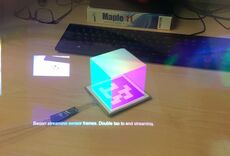HoloLens
| Microsoft HoloLens | |
|---|---|

|
|
| Developer | Microsoft Corporation |
| Operating system | NA |
| Resolution | 1268x720 |
| Field of view | NA |
| Weight | grams |
| Controls | |
The Hololens is an augmented reality headset from Microsoft. It has a transparent display and 3D tracking. It is called "HoloLens" because it enables users to see what Microsoft calls "holograms". It features a pair of optical see through near-eye displays.
The eye-piece components of HoloLens are transparent. It is able to display 3D virtual objects as if they were in the real world through its see-through displays.[1][2]
The HoloLens was developed at about the same time as the Magic Leap 1.
It requires a Microsoft account to set up.
Microsoft HoloLens has a Windows 10 computer built in. It has sensors, including cameras for camera-based tracking.
Operation[edit]
HoloLens uses cameras to track the environment and establish a frame of reference.
Displays[edit]
The field of view (FOV) is small: 30 degrees horizontal and 17.5 degrees vertical.
Its total diagonal FOV is about 30 degrees.[3]
It is optically comparable with the Hololens 2 and the Magic Leap 1.
3D tracking[edit]
Sensors include head tracking IMUs (Inertial Measuring Unit), a depth camera with 120°×120° FOV, an RGB 2-megapixel photo / HD video camera and an ambient light sensor. Additionally, it has 4 greyscale environment sensing cameras that work with the depth camera to track the head, hands and the surrounding environment.
Processors[edit]
For processors, in addition to CPU and GPU, HoloLens has an HPU, (holographic processing unit). The HPU consolidates and processes all the data from various sensors and produces a stream of useful information to the other processors. HPU removes the burden from the CPU and GPU of handling heavy external data.
HPU - processes all of the data from its sensors, depth camera, microphone etc.
Power and Connectivity[edit]
The battery in HoloLens lasts around 2.5 hours during intensive use. It lasts around 5.5 hours during less intensive use.
HoloLens can connect to any WiFi or Bluetooth-equipped device.
HoloLens can run any universal Windows 10 app.
A microUSB port is present for charging and connection. It is possible to use Microsoft HoloLens while it’s charging over microUSB.[4]
Announcement and Release[edit]
Microsoft HoloLens was announced during a Windows 10 Event. The Development Edition was released for $3,000 or £2,000. It allowed developers to start making apps and games for the headset. Months later, it became available to anyone with a Microsoft account.[4][5]
Features[edit]
3D projections that can be anchored in the real world. These virtual objects are projected at about 60 cm (near plane) to few meters.
Spatial Mapping - scans the environment in real time to create a mesh of an X/Y/Z coordinate plane. Objects can be projected into the mesh.
Gaze Recognition - HoloLens tracks your gaze.
Input gadgets[edit]
HoloLens Clicker - a small clicker with a loop that wraps around your middle or index finger. It is held with the microUSB port towards your body and your thumb resting on top of the click, in the indentation. The clicker features a single button and rotational tracking. It allows a user to click and scroll with minimal hand motion as a replacement for the air-tap gesture.
Bluetooth Mouse and Keyboard
Software[edit]
The HoloLens user interface consists of a bunch of floating windows, and some 3D objects.
List of HoloLens 1 applications
Development[edit]
Hololens uses Windows Mixed Reality, based on Windows 10.
To develop for HoloLens, you need a Windows 10 PC able to run Visual Studio 2015 and Unity.
There is a HoloLens Emulator that allows the user to test Holographic apps on their PCs without the need of a physical HoloLens. It is simulated using a keyboard, mouse, and/or xbox controller. The human and environmental inputs that would usually be read by the sensors on the HoloLens are instead simulated using your keyboard, mouse, or Xbox controller. Apps don't need to be modified to run on the emulator and don't know that they aren't running on a real HoloLens.[6]
References[edit]
- ↑ Microsoft. Microsoft HoloLens. Retrieved from https://www.microsoft.com/en-us/hololens
- ↑ Microsoft. Why HoloLens. Retrieved from https://www.microsoft.com/en-us/hololens/why-hololens
- ↑ "How does the Hololens 2 matter?". 2019-02-24. https://stevesspace.com/2019/02/how-does-hololens2-matter/.
- ↑ 4.0 4.1 Cite error: Invalid
<ref>tag; no text was provided for refs named”four” - ↑ Spence, E. (2017). Microsoft HoloLens Review: Winning the reality wars. Retrieved from https://www.forbes.com/sites/ewanspence/2017/01/14/microsoft-hololens-review-experience-review/2/#4053cf3d43f9
- ↑ Microsoft. Using the HoloLens emulator. Retrieved from https://developer.microsoft.com/en-us/windows/holographic/using_the_hololens_emulator

